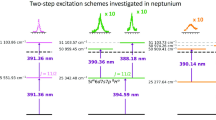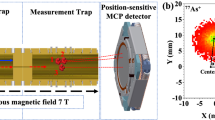Abstract
Precision spectroscopic comparison of hydrogen and antihydrogen holds the promise of a sensitive test of the Charge-Parity-Time theorem and matter-antimatter equivalence. The clearest path towards realising this goal is to hold a sample of antihydrogen in an atomic trap for interrogation by electromagnetic radiation. Achieving this poses a huge experimental challenge, as state-of-the-art magnetic-minimum atom traps have well depths of only ∼1 T (∼0.5 K for ground state antihydrogen atoms). The atoms annihilate on contact with matter and must be ‘born’ inside the magnetic trap with low kinetic energies. At the ALPHA experiment, antihydrogen atoms are produced from antiprotons and positrons stored in the form of non-neutral plasmas, where the typical electrostatic potential energy per particle is on the order of electronvolts, more than 104 times the maximum trappable kinetic energy. In November 2010, ALPHA published the observation of 38 antiproton annihilations due to antihydrogen atoms that had been trapped for at least 172 ms and then released—the first instance of a purely antimatter atomic system confined for any length of time (Andresen et al., Nature 468:673, 2010). We present a description of the main components of the ALPHA traps and detectors that were key to realising this result. We discuss how the antihydrogen atoms were identified and how they were discriminated from the background processes. Since the results published in Andresen et al. (Nature 468:673, 2010), refinements in the antihydrogen production technique have allowed many more antihydrogen atoms to be trapped, and held for much longer times. We have identified antihydrogen atoms that have been trapped for at least 1,000 s in the apparatus (Andresen et al., Nature Physics 7:558, 2011). This is more than sufficient time to interrogate the atoms spectroscopically, as well as to ensure that they have relaxed to their ground state.
Similar content being viewed by others
References
Andresen, G.B., et al. (ALPHA): Nature 468, 673 (2010)
Andresen, G.B., et al. (ALPHA): Nature Physics 7, 558 (2011)
Niering, M., et al.: Phys. Rev. Lett. 84, 5496 (2000)
Hellwig, H., et al.: IEEE Trans. Instrum. Meas. IM-19, 200 (1970)
Amoretti, M., et al. (ATHENA): Nature 419, 456 (2002)
Gabrielse, G., et al. (ATRAP): Phys. Rev. Lett. 89, 233401 (2002)
Pritchard, D.E.: Phys. Rev. Lett. 51, 1336 (1983)
Gilson, E.P., Fajans, J.: Phys. Rev. Lett. 90, 015001 (2003)
Bertsche, W., et al. (ALPHA): Nucl. Instrum. Methods Phys. Res. A 566, 746 (2006)
Hydomako, R.. et al. (ALPHA): Antihydrogen detection in ALPHA. (this conference)
Andresen, G.B., et al. (ALPHA): Phys. Lett. B 695, 95 (2011)
Gabrielse, G., et al.: Phys. Lett. A 129, 38 (1988)
Madsen, N., et al. (ATHENA): Phys. Rev. Lett. 94, 033403 (2005)
Andresen, G.B., et al. (ALPHA): Phys. Rev. Lett. 106, 025002 (2011)
Bertsche, W., et al. (ALPHA): Antihydrogen formation by autoresonant excitation of antiproton plasmas. (this conference)
So, C., et al. (ALPHA): Autoresonant mixing simulation in the ALPHA apparatus. (this conference)
Hurt, J., et al.: J. Phys. B: At. Mol. Opt. Phys. 41, 165206 (2008)
Davis, K.B., et al.: Phys. Rev. Lett. 74, 5202 (1995)
Andresen, G.B., et al. (ALPHA): Phys. Rev. Lett. 105, 013003 (2010)
Silveria, D., et al. (ALPHA): Evaporative cooling of antiprotons and positrons for the production of trappable antihydrogen. (this conference)
Ashkezari, M., et al. (ALPHA): Progress towards microwave spectroscopy of trapped antihydrogen. (this conference)
Author information
Authors and Affiliations
Consortia
Corresponding author
Rights and permissions
About this article
Cite this article
Butler, E., Andresen, G.B., Ashkezari, M.D. et al. Trapped antihydrogen. Hyperfine Interact 212, 15–29 (2012). https://doi.org/10.1007/s10751-011-0396-3
Published:
Issue Date:
DOI: https://doi.org/10.1007/s10751-011-0396-3




